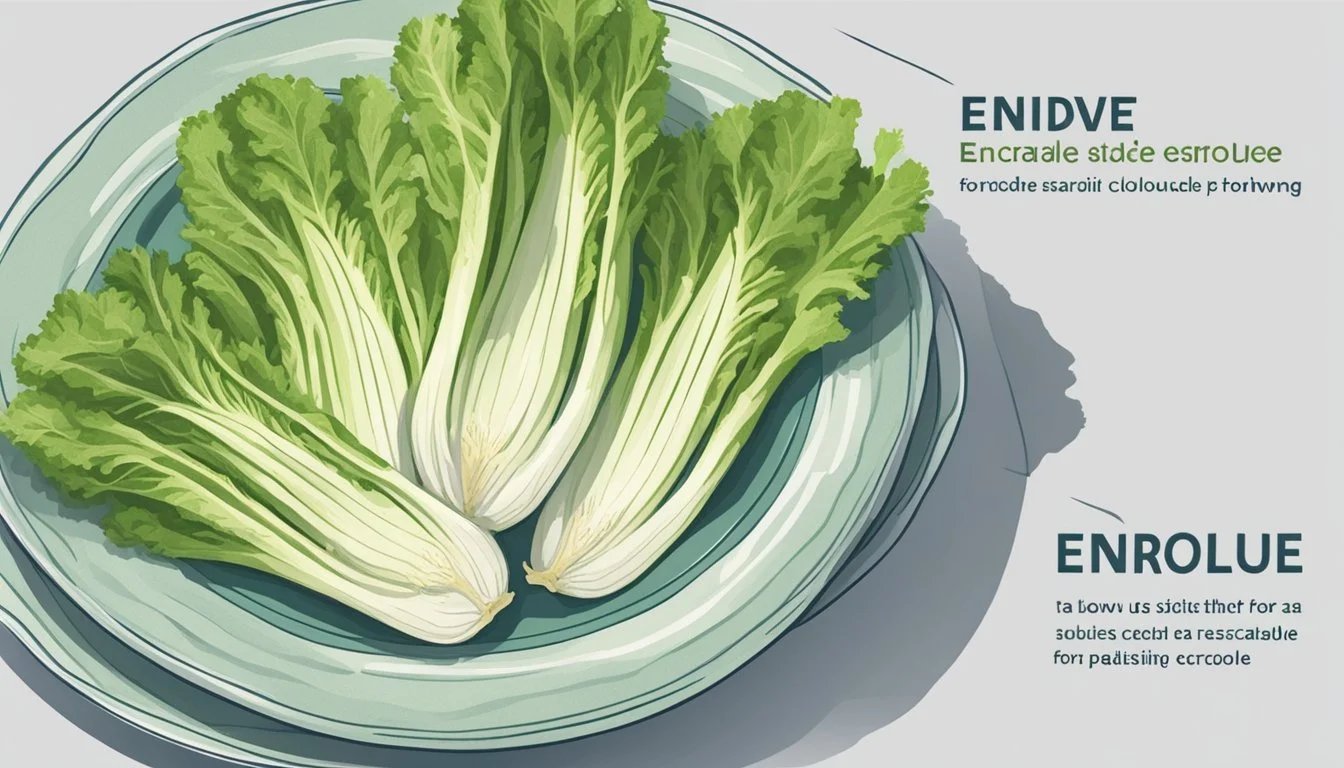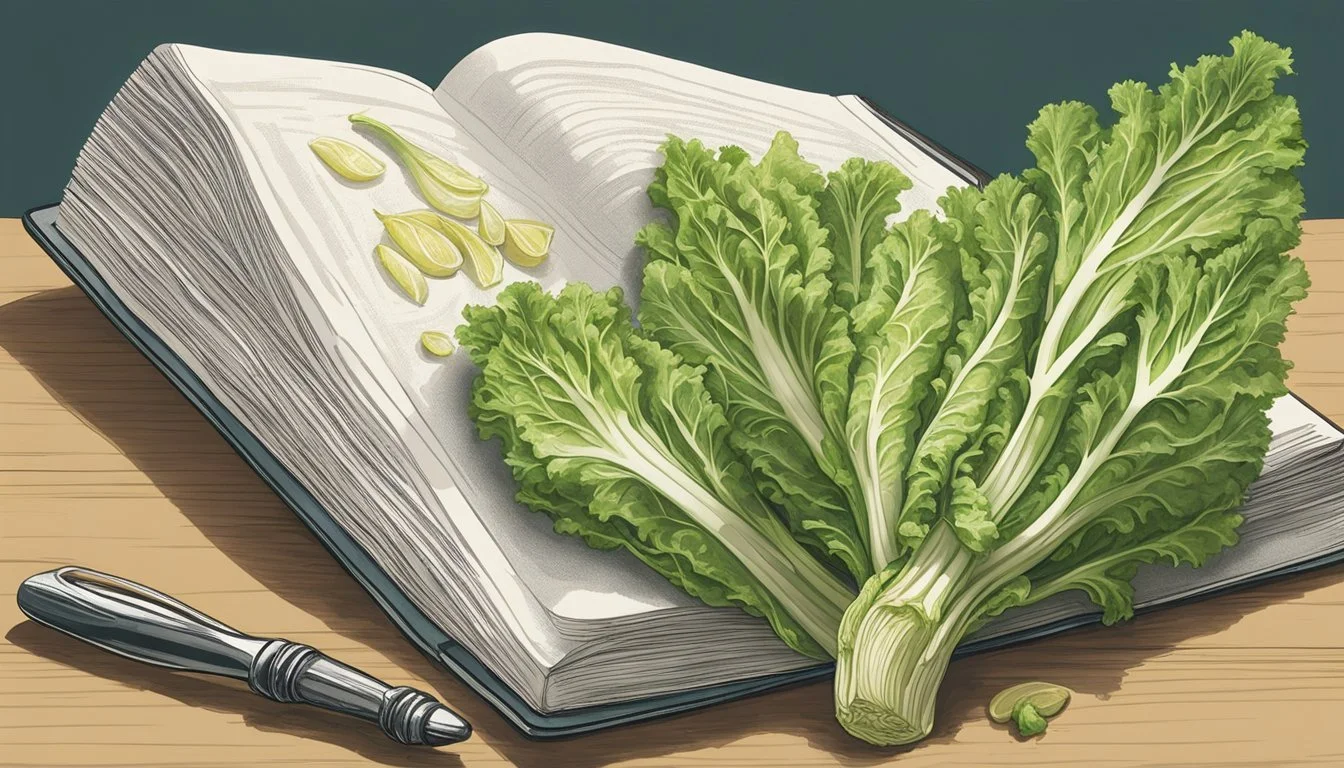How to Substitute Endive for Escarole
A Simple Swap Guide
Endive and escarole are leafy greens from the chicory family that offer distinctive tastes and textures in various dishes within the realm of cuisine. Although they share a botanical lineage, their characteristics are unique enough to merit a closer examination, especially when considering substitutions in recipes. Endive, known for its crisp texture and slightly bitter taste, often appears raw in salads (What wine goes well with salads?) or serves as a vessel for appetizers (What wine goes well with appetizers?). Its pointed leaves and tight head contribute not only sharp flavors but also an aesthetic flair to culinary creations.
When substituting endive for escarole, it's important to consider the textural changes alongside the flavor profile it will bring to the dish. Escarole boasts broader, flatter leaves and presents a milder bitterness compared to endive. This makes it a versatile green, commonly used both raw and cooked, in a variety of European and American dishes. Substitutions should be approached with the understanding that endive may introduce a more pronounced bitterness and a crunchier bite, aspects that could potentially enhance a given recipe or contrast with its intended essence.
Chefs and home cooks alike may find themselves in situations where escarole is unavailable, prompting a need for suitable alternatives. In the context of substituting endive for escarole, one will discover that endive can adeptly complement the flavors in salads, sandwiches, and even cooked applications, albeit with a peppery kick. With a confidence grounded in the knowledge of these leafy greens, incorporating endive as a stand-in for escarole can be seamlessly executed without compromising the integrity of classic dishes that traditionally rely on the subtle, earthy notes of escarole.
Understanding Endive and Escarole
When substituting endive for escarole, understanding their distinct characteristics is essential, including their botanical relation, typical culinary uses, and individual nutritional benefits.
Botanical Background
The chicory family encompasses a variety of leafy green vegetables, including endive and escarole. Both vegetables share a common ancestry, with endive being classified into three main types: Belgian endive, curly endive (also known as frisée), and Batavian endive or broad-leaved endive. Escarole, also referred to as broad-leaved endive, showcases broader and less curly leaves than its counterpart, curly endive. This family is known for its characteristic bitterness, which varies among the different types.
Culinary Uses
Endive and escarole are versatile in the kitchen. Endive, especially the Belgian and curly varieties, is often incorporated raw in salads for its crisp texture and peppery taste. Belgian endive can also be cooked or used as a vessel for appetizers. Escarole, being less bitter, is regularly used in cooking, excelling in soups and stews, and pairs well with beans. Its leaves are sturdy enough to withstand heat without losing texture.
Nutritional Profiles
Both endive and escarole are low in calories and dense in nutrients, making them beneficial for a healthy diet. They are rich sources of dietary fiber, which aids digestion. Additionally, they provide a good variety of vitamins and minerals, including:
Vitamin K: Crucial for blood clotting and bone health.
Folate: Important for cell function and tissue growth.
Vitamin A: Supports immune function, vision, and skin health.
Vitamin C: Antioxidant that aids in the repair of all body tissues.
Calcium: Essential for bones and teeth.
Magnesium, Potassium, Iron: Minerals that support various physiological processes.
Here's a simple comparative table of the nutritional content of endive and escarole per 100 grams:
Nutrient Endive Escarole Calories 17 23 Fiber (grams) ~1.6 ~1.2 Vitamin K High High Vitamin A Moderate Moderate Vitamin C Moderate Moderate
Both vegetables offer antioxidants which are compounds that can protect the body from oxidative stress. Incorporating endive and escarole into meals can contribute positively to one's overall health.
Physical and Flavor Characteristics
When substituting endive for escarole, it is essential for the reader to consider how these leafy greens differ in texture and flavor. These factors significantly impact the culinary experience and outcome of a recipe.
Texture and Appearance
Endive typically exhibits a crisp texture and consists of narrow, pointed leaves that form a tight head, often likened to a tulip shape. Its leaves showcase a pale yellow to green gradient, with a firm and crunchy feel. Escarole, conversely, boasts broader and flatter leaves with a more flexible nature, which can also contribute a slightly ruffled appearance to dishes. Both greens fall under the category of bitter greens, but their physical attributes set them apart in preparation and presentation.
Taste Profile
The taste profile of endive and escarole varies subtly yet notably. Endive carries a slightly bitter yet refreshing flavor with a peppery kick, while escarole is best described as having a milder bitterness and is less pronounced in terms of peppery notes. This milder flavor profile can adapt well and complement the sweetness in various dishes. One can harness the inherent bitter taste of these greens to contrast with and balance the sweet flavors or ingredients within a recipe, ultimately enhancing the dish's overall palatability.
Cooking Techniques and Applications
When substituting endive for escarole, it's essential to understand how its characteristics affect various cooking methods and the final taste of dishes. The robust flavor and texture of endive can enhance meals when used appropriately.
Preparation Methods
Endive's crisp and curly leaves are suitable for raw and cooked applications, similar to those of escarole. Raw endive can be sliced for salads or separated into leaves for appetizers. When cooking, one might consider:
Chopping for soups or stews
Sautéing as a side or for incorporating into pasta dishes
Braising to soften the leaves for a milder flavor profile
Recipe Ideas
In culinary applications, endive can readily replace escarole across a variety of dishes:
Salads: Use raw, sliced endive for added crunch and a slight bitterness.
Italian Wedding Soup: Substitute endive for escarole for its comparable bitter flavor.
Pasta Dishes: Incorporate sautéed endive for a touch of complexity.
Sandwiches: Layer raw endive for added texture and zest.
Baked Goods: Implement endive in casseroles and baked dishes for a resilient green.
Cooking Tips
Understanding the nuances of endive will aid in seamlessly integrating it into recipes traditionally calling for escarole:
Stir-Fries and Sautéed Dishes: (What Wine Pairs Best with Sautéed Dishes) Add endive towards the end of cooking to maintain some crunch.
Soups and Stews: Endive can be added earlier to allow the leaves to soften and flavors to meld.
Braising: Cooking endive with a little liquid on low heat will reduce its bitterness and tenderize the greens.
Grilling: Lightly oil and grill endive for a charred, smoky side dish.
By applying these techniques, one can successfully use endive as a substitute for escarole in a variety of dishes without compromising flavor or texture.
Substituting Endive for Escarole
When substituting endive for escarole, the reader should consider factors such as flavor and texture differences. The following guidelines are designed to help make successful substitutions in recipes where escarole is called for.
When to Substitute
Endive can be substituted for escarole when a recipe requires a slightly bitter flavor or a crisp texture. This is effective in raw applications like salads or when serving as a base for appetizers. The substitution works best in dishes where escarole would be used raw.
How to Adjust for Taste and Texture
Escarole has broad, pale leaves and a milder bitterness compared to endive. When using endive as a substitute, one should:
Reduce Quantity: Use endive sparingly to avoid overwhelming the dish with bitterness.
Consider Cooking: If a recipe uses cooked escarole, lightly sauté endive to mellow its flavor.
Best Substitute Options
The best substitutes for escarole go beyond endive and include a variety of leafy greens, each with unique qualities:
Substitute Flavor Notes Texture Best Used In Arugula Peppery, less bitter Tender Raw salads Chicory Bitter Crisp Cooked/blanched dishes Spinach Mild, slightly bitter Soft Soups, sautéed Curly Kale Peppery, hearty Firm Cooked dishes Swiss Chard Mild, slightly sweet Soft Braised, soups
For robust dishes, heartier greens like kale, chard, or collard greens can withstand heat and maintain structure, while tender greens like spinach or baby kale work well for dishes with minimal cooking.
Pairing Ingredients with Endive
Endive, known for its crisp texture and slightly bitter taste, is versatile and pairs well with a range of ingredients that complement or balance its flavor profile.
Complementary Flavors
When using endive in place of escarole, it’s beneficial to pair it with ingredients that complement its bitterness. Olive oil and garlic, for instance, can be used to create a savory sauté that mellows out the bitterness. For salads, combining endive with mustard or a vinaigrette dressing can accentuate its peppery notes.
Nuts: Walnuts or pine nuts add a rich, earthy crunch.
Frisée: Another mildly bitter green, frisée can blend with endive for a complex salad base.
Creating Balanced Dishes
Balancing the bitter flavor of endive is key to ensuring it complements a dish. It holds up well with the saltiness and savoriness of bacon or the robust flavors of various meats.
Beans: Pairing endive with beans adds creaminess and provides a contrast in both texture and taste.
Vinaigrette: A sweet or acidic dressing can counterbalance bitterness.
For a harmonious dish, considering the balance between bitter, savory, and sweet is crucial. By artfully combining endive with these ingredients, one can create dishes that delight the palate.
Similarities and Differences
Understanding the characteristics of endive and escarole is crucial for effective substitution in recipes. Their resemblance in flavor profile and nutritional content makes them interchangeable in many dishes, yet their distinct textural and physical attributes should guide their specific use in the kitchen.
Comparison of Endive and Escarole
Endive and escarole are both members of the chicory family, which contributes to their similar bitter taste, a distinctive feature in Italian cuisine. They also share a resemblance in nutrient composition, being low in calories and high in dietary fiber. However, their appearance and texture present clear differences:
Endive: Characterized by its finely cut, narrow, and curly leaves, forming a tighter head. Endives present a slightly bitter taste and a crisp texture.
Escarole: Features smooth, broad, rounded leaves that are less bitter, offering a milder flavor and a softer texture compared to endives.
Trait Endive Escarole Leaf Shape Narrow and curly Broad and rounded Texture Crisp and frizzy Smooth and softer Bitterness Slightly bitter Milder bitterness Best Used Raw in salads Cooked or raw Caloric Value 17 calories/100g 23 calories/100g
Choosing Between the Two
When substituting endive for escarole, one must consider the intended application within a dish. If a recipe calls for escarole in soups or cooked applications, endive may not hold up as well due to its frizzier leaves and higher bitterness, which intensify when cooked. Conversely, the milder and more hearty nature of escarole leaves makes them more versatile for both cooking and fresh preparations.
For raw dishes like salads, where endive is traditionally favored for its crunchy texture, escarole can be used as a substitute provided its leaves are chopped to match the desired texture and aesthetic of the dish. Its larger leaves and milder bitterness can also add variation to the salad's overall balance of flavors.
Seasonal and Regional Considerations
When substituting endive for escarole, it's essential to consider the availability and characteristics of these leafy greens throughout different seasons and regions. These aspects can influence both the flavor and utility of the greens in various dishes.
Availability by Season
Spring: Endive is typically available year-round; however, escarole tends to peak in the spring. This distinction is critical because spring escarole will usually be more tender and have a milder bitterness compared to other seasons.
Cultivation Regions
Regional Variations: Endive and escarole each have preferred growing conditions which can lead to regional specializations. For instance, places with cooler climates may have better-quality escarole in the spring, reflective of its optimal growing conditions. Conversely, endive, being more hardy, is found in a variety of regions with minimal variation in taste or texture.









